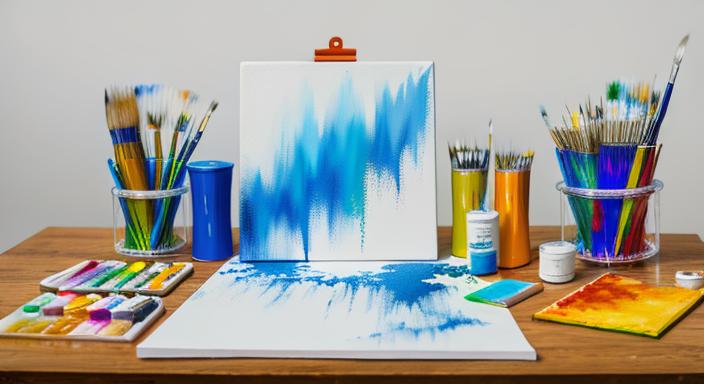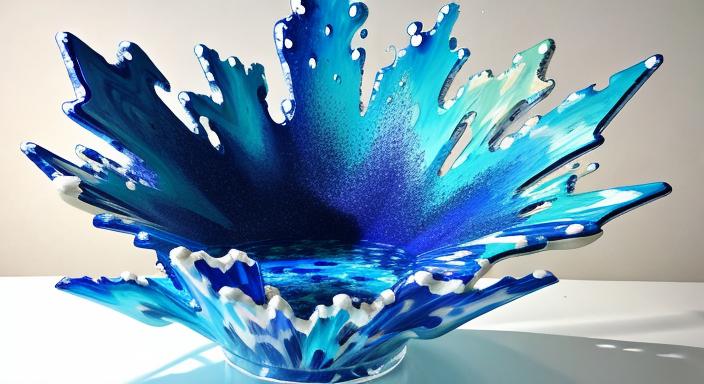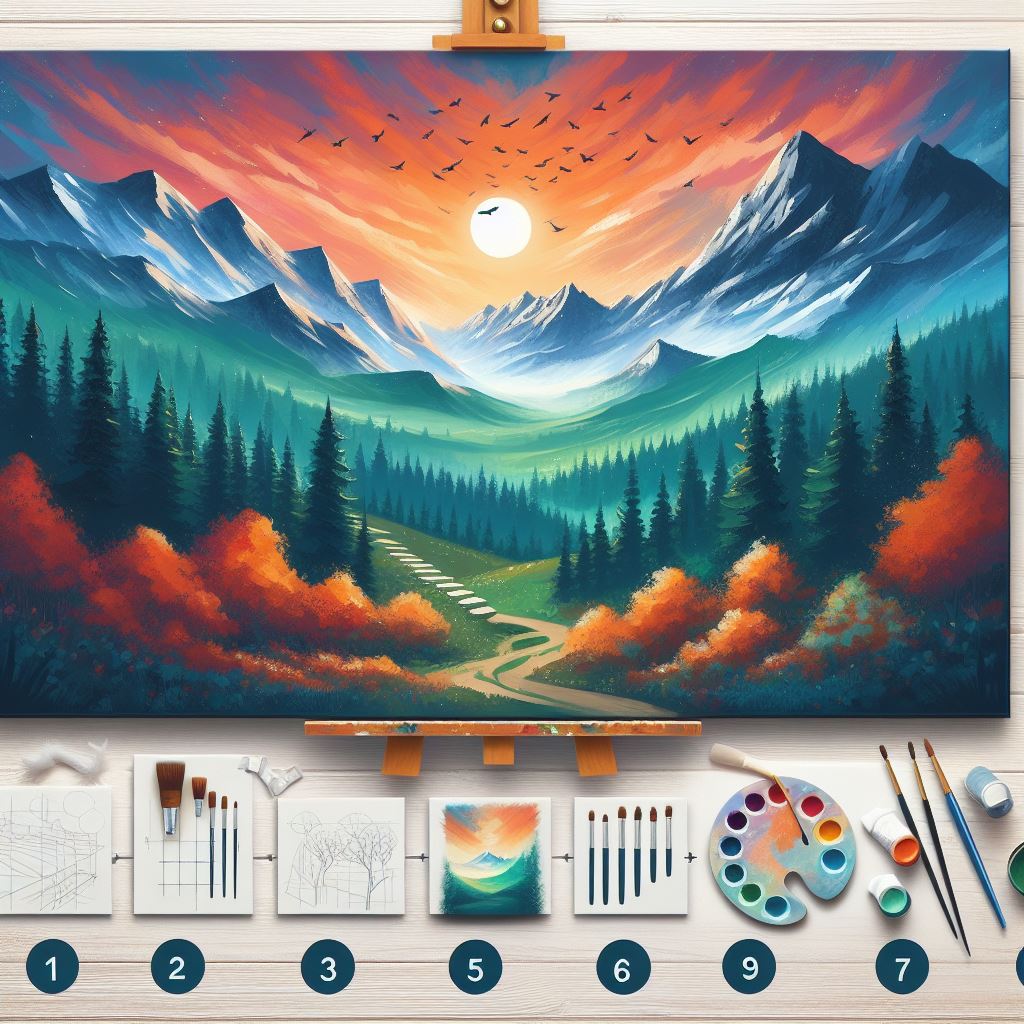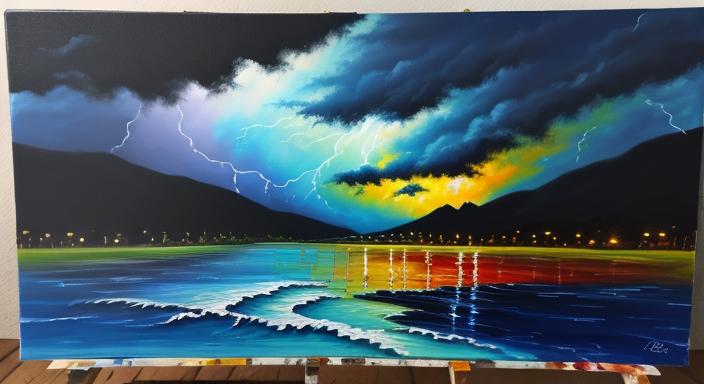Acrylic painting is a versatile and rewarding medium that can be enjoyed by artists of all levels. Whether you’re a beginner just starting out or an experienced artist looking to expand your skills, having the right acrylic painting suppies is essential for creating stunning acrylic artwork.

In this comprehensive guide, we’ll cover everything you need to know about acrylic painting materials, from paints and canvases to brushes and mediums.
Basic Acrylic Painting Materials for Beginners (Summary)
| Material | Description | Importance |
|---|---|---|
| Acrylic Paints | Water-based paints that come in student-grade (more affordable) and professional-grade (higher pigment concentration) varieties. | The core of your acrylic painting kit! |
| Canvases | The surface you paint on. Stretched canvases are the most convenient, while canvas panels are great for portability. | Provides the foundation for your artwork. |
| Brushes | Used to apply paint. Start with a few essentials: flat, round, and filbert brushes in both bristle and synthetic varieties. | Your main tool for putting paint onto the canvas. |
| Acrylic Mediums (Optional) | Substances that alter how acrylic paint behaves (gels, glazes, retarders). | Expand your creative possibilities, but not strictly necessary at the beginner stage. |
| Palette | A surface for mixing paints. Plastic palettes are inexpensive, stay-wet palettes keep acrylics from drying out too quickly. | Essential for mixing colors and controlling paint consistency. |
| Palette Knife (Optional) | A tool for mixing paint and creating unique textures on canvas. | Great for experimenting, but not crucial for starting out. |
| Water Container | For cleaning brushes and thinning acrylics as needed. | Acrylics dry fast, so keeping brushes wet is important. |
| Paper Towels or Rags | Essential for cleanup, blotting brushes, and manipulating paint. | Keeps your workspace tidy and lets you control paint effects. |
Additional Notes for Beginners:
- Start small: Begin with a limited color palette and a few essential brushes while you learn the basics.
- Consider a kit: Many art stores offer beginner acrylic painting kits with the basics to get you started.
- Easel: While optional, an easel can enhance your painting experience by holding your canvas at a comfortable angle.
Essential Acrylic Painting Supplies for Beginners
A. Acrylic Paints
Acrylic paints are made from a water-based acrylic polymer emulsion. They are known for their fast drying time, versatility, and durability. Acrylics can be used on a variety of surfaces, including canvas, paper, wood, and metal.
Types of Acrylic Paints:
- Student Grade: These paints are typically less expensive and have a lower pigment load. They are suitable for beginners and hobbyists.
- Professional Grade: These paints have a higher pigment load and are more durable. They are preferred by professional artists and serious hobbyists.
- Heavy Body: These paints have a thick, paste-like consistency. They are ideal for creating textured effects and impasto paintings.
- Fluid: These paints have a thin, liquid consistency. They are perfect for washes, glazes, and airbrushing.
Choosing the Right Acrylic Paints:
- Consider your skill level and budget.
- Read reviews and ask for recommendations from other artists.
- Experiment with different brands and types of paints to find what works best for you.
B. Canvases
Canvases are the surface on which you paint. They come in a variety of sizes, shapes, and materials.
Different Types of Canvases:
- Stretched Canvas: These canvases are pre-stretched over a wooden frame. They are the most convenient option for most artists.
- Unstretched Canvas: These canvases are not stretched over a frame. They are more affordable than stretched canvases, but you will need to stretch them yourself before painting.
- Canvas Panels: These canvases are made from a thin layer of canvas mounted on a rigid backing. They are lightweight and portable, making them ideal for plein air painting.
Selecting the Best Canvas for Your Needs:
- Choose a canvas that is the right size and shape for your painting.
- Consider the texture of the canvas. Some canvases have a smooth surface, while others have a more textured surface.
- Choose a canvas that is made from a durable material. Canvases made from linen or cotton are typically more durable than canvases made from synthetic materials.
C. The Right Acrylic Painting Brushes: Shapes and Uses
Brushes are used to apply paint to the canvas. They come in a variety of shapes and sizes, each designed for a specific purpose.
Types of Brushes for Acrylic Painting:
- Flat Brushes: These brushes have a flat, rectangular shape. They are used for creating broad strokes and filling in large areas.
- Round Brushes: These brushes have a round, pointed tip. They are used for creating fine lines and details.
- Filbert Brushes: These brushes have a flat, oval shape. They are used for blending colors and creating smooth transitions.
- Bristle Brushes: These brushes are made from natural bristles. They are stiff and durable, making them ideal for applying heavy-bodied paints.
- Synthetic Brushes: These brushes are made from synthetic fibers. They are soft and flexible, making them ideal for applying fluid paints.
How to Choose the Right Brushes:
- Consider the type of paint you are using. Different types of paints require different types of brushes.
- Choose brushes that are the right size and shape for your painting.
- Invest in good quality brushes. Good brushes will last longer and produce better results.
D. Acrylic Mediums: Change the Game
Mediums are used to change the properties of acrylic paints. They can be used to thin the paint, make it more transparent, or add texture.
Different Types of Mediums:
- Gels: Gels are used to thicken the paint and create textured effects.
- Glazing Mediums: Glazing mediums are used to make the paint more transparent. They are ideal for creating washes and glazes.
- Retarders: Retarders are used to slow down the drying time of the paint. They are ideal for working on large paintings or for creating blended effects.
- Varnishes: Varnishes are used to protect the finished painting from UV rays and dust. They also add a glossy or matte finish to the painting.
Choosing the Right Mediums:
- Consider the effect you want to achieve. Different mediums produce different effects.
- Experiment with different mediums to find what works best for you.
E. Varnishes
Varnishes are used to protect the finished painting from UV rays and dust. They also add a glossy or matte finish to the painting.
Types of Varnishes:
- Gloss Varnish: Gloss varnish creates a shiny, reflective finish.
- Matte Varnish: Matte varnish creates a flat, non-reflective finish.
- Satin Varnish: Satin varnish creates a finish that is somewhere between gloss and matte.
Choosing the Right Varnish:
- Consider the desired finish for your painting.
- Choose a varnish that is compatible with the type of paint you used.
F. Other Helpful Tools
- Palette: Plastic or stay-wet palettes are both useful.
- Palette Knives: For mixing and unique paint application.
- Water Container: Keeps brushes wet, crucial for acrylics.
- Paper Towels/Rags: Cleanup and paint manipulation.
- Easel (optional): Holds your work at a comfortable angle.
Tips for Choosing the Right Acrylic Painting Materials
- Consider your skill level. Beginners may want to start with less expensive materials, while experienced artists may prefer to invest in higher-quality materials.
- Think about your budget. Acrylic painting materials can range in price from inexpensive to expensive. Set a budget before you start shopping so that you don’t overspend.
- Read reviews and ask for recommendations from other artists. This can help you find the best materials for your needs.
- Experiment with different materials. The best way to find out what works best for you is to experiment with different brands and types of materials.
Resources and Inspiration
- Recommended Online Stores: Great selection as always on Amazon, also Blick Art Materials, Jackson’s Art Supplies, Jerry’s Artarama
- More Acrylic Painting Guides: More about Acrylic Painting
- Inspiring Acrylic Artists: see below
- Ashley Longshore: https://www.ashleylongshore.com/ (Vibrant, pop-art inspired)
- Flora Bowley: https://florabowley.com/ (Intuitive, fluid painting style)
- Nicholas Wilton: https://www.nicholaswilton.com/ (Bold, colorful, large-scale works)
Conclusion
Having the right acrylic painting materials is essential for creating stunning artworks. By following the tips in this guide, you can choose the materials that are right for your skill level, budget, and artistic style.
With the right materials in hand, you’re ready to start creating beautiful acrylic paintings that will bring joy to you and others for years to come.


